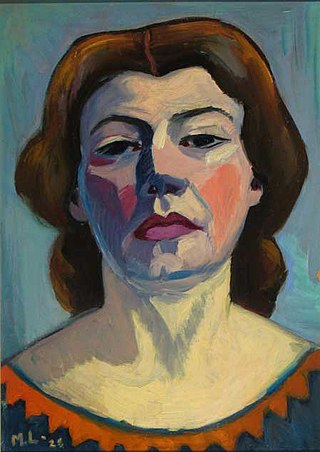Life
Maurice van Essche was born 1906, in Antwerp, Belgium, the seventh of eleven children, of whom only eight survived infancy. The family was French-speaking despite its Flemish roots; his mother's maiden name was De Ridder. He studied art at the Brussels Academy in 1924 under James Ensor, but halted his studies in 1925 for lack of funding, first working in a stained glass studio, then designing wallpaper – both of which experiences are actively reflected in many of his works. He also worked as a freelance cartoonist, but painted all the while. In 1933 he studied briefly under Henri Matisse in France (see Anecdotes), having met him by chance in an artist's supply shop in Cagnes, France. Thereafter he continued to paint and study full-time thanks to the sponsorship of his elder brother, Joseph Charles, and a group of friends.
His break came in July 1939 when he won a scholarship in a competition organised by the Belgian Government, who commissioned him to undertake a painting expedition to the Belgian Congo. His travels and experiences there influenced him profoundly, and the visions and emotions of that period echoed through his work for the rest of his life. In 1940 his wife Lucette (née Josz, practicing Catholic but of Hungarian Ashkenazy descent on her father's side, 1908–1997) and son Ludovic (1935–2020) fled German occupation of Belgium and joined him in the Congo. Lucette could not cope with tropical conditions and they moved to the relatively milder climate of the South African Cape rather than return to war-torn Europe.
Early days in South Africa were difficult, and on occasion van Essche traded paintings and drawings for food and other essentials. But he soon became a prominent member of the South African art community, exhibiting locally and later in Europe as well. As an active member of The New Group he contributed strongly to contemporary art in South Africa. He had a solid knowledge of both modern art trends and the history of European painting which he imparted in his role as teacher, a profession he regarded as equally important as creating. He taught at the [1] Technical Art School from 1943 to 1945. In 1948 he founded the Continental School of Art in Cape Town, leaving in 1951 to become a lecturer at the Michaelis School of Fine Art at the University of Cape Town. He was appointed Professor of Fine Art in 1962 (see Anecdotes) and his success as a teacher is attested to by the number of his former pupils who have become prominent artists themselves.
Van Essche retired from academia in 1971, but continued to paint prolifically, despite poor health, including several heart attacks. He travelled in Europe and eventually settled near Thonon, France, at his wife's behest. His health continued to deteriorate, and he could not travel to attend his own retrospective exhibition in Cape Town in 1974. He missed Africa terribly, painting African scenes while searching in vain for local inspiration. His new themes included hippies and musicians, but he destroyed much of this work. His European landscapes from this period are dark and depressed, in stark contrast to the vibrant African scenes that flowed nonetheless. His oils continued to sell well in South Africa, and his reputation grew. He succumbed to a heart attack in June 1977 following a fall, and poor medical care.
Art
Van Essche's work exhibits contrasting influences, both artistic and environmental. From delicate renditions of the diffused tones of Flanders, to powerful depictions of Africa's landscapes, people and light, van Essche conveys unmistakable moods and a realism that is both beautifully poetic and strikingly honest. "There must be blood in my painting... I must remain human at all costs," he wrote to his friend Baron Robert d'Huart in 1961.
Anecdotes
Relationship with Henri Matisse: Maurice van Essche met Henri Matisse when buying paint in an artists' supply shop in 1933 in Cagnes, in the south of France. van Essche had just purchased the last tube of Lemon Yellow when Matisse entered the store and asked the clerk for the same article. On recognising the famous man, van Essche offered him the tube of paint. Matisse declined, but touched by the gesture invited van Essche to visit his studio. They formed a strong friendship and Matisse coached the young artist while in Cagnes, and later again in Paris.
Resemblance to Le Corbusier: On his visits to Paris before and after the war, van Essche frequented many well-known contemporary artists and architects of the time. Due to some similarities in appearance, and especially the style of glasses both men wore, he was often mistaken for Le Corbusier, much to his delight and amusement. It is unknown whether the two ever met.
As Professor of Fine Art at the University of Cape Town van Essche shared the position of Dean of Art and Architecture on an annual rotating basis with William Leonard Thornton WHITE, referred to by colleagues and friends as Thornton-White, until Thornton-White's death in 1965.
Direct descendant of Peter Paul Rubens: In the book on Maurice van Essche by Carl Büchner, published by Tafelberg in 1967, Büchner mentions van Essche's direct descendance from the flemish grand master, a claim originating from and sustained by van Essche himself. While there is no reason to doubt van Essche's good faith, the basis for the claim is unknown and direct descendance has not been researched or proven to date.
This page is based on this
Wikipedia article Text is available under the
CC BY-SA 4.0 license; additional terms may apply.
Images, videos and audio are available under their respective licenses.















